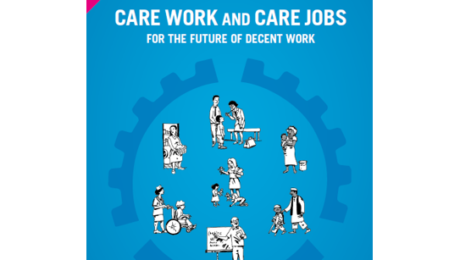ILO Releases New Report on Care Work and Care Jobs
In June the International Labour Organization released their new report Care Work and Care Jobs for the Future of Decent Work. The report analyses the ways in which unpaid care work is recognized and organized, the extent and quality of care jobs and their impact on the well-being of individuals and society. A key focus of this report is the persistent gender inequalities in households and the labour market, which are inextricably linked with care work. These gender inequalities must be overcome to make care work decent and to ensure a future of decent work for both women and men.
The report contains a wealth of original data drawn from over 90 countries and details transformative policy measures in five main areas: care, macroeconomics, labour, social protection and migration. It also presents projections on the potential for decent care job creation offered by remedying current care work deficits and meeting the related targets of the Sustainable Development Goals.
Care Work and the Economy researcher Kijong Kim contributed a background study, co-authored with Ipek Ilkkaracan (Istanbul Technical University), entitled The Employment Generation Impact of Meeting SDG Targets in Early Childhood Care, Education, Health and Long-Term Care in 45 Countries.
- Published in Policy
The Progression of South Korea’s Childcare Model
South Korea’s childcare model started developing when the Child Welfare Act (the Act) was first introduced in 1962. Prior to that, no solid policy for childcare existed, as the country was in a period of political and social turmoil after the Korean war (1950-1953). Thanks to the Act, several nursery facilities were built during this period with foreign assistance, although with the narrow objective of relieving the poor and supporting numerous orphans who lost their parents during the war (Kang, 2002). The Child Welfare Act of 1962 initiated a structured system-level approach to the childcare sector. The Act was still grounded in the notion that families are solely responsible for childrearing unless the children have special needs, in which case government support and protection is warranted. The 1962 law shows clearly that the South Korean government envisioned childcare as a family responsibility, rather than a social policy, which is in accordance with other countries yet to introduce a social welfare system.
However, from the 1960s, when South Korea went through industrialization, the male breadwinner model, which reflected the predominant household type, underwent significant changes. Former housewives started to enter the labor market and a new apparatus was needed to take care of children who were left at home. As a result, the Act for the Promotion of Early Childhood Education (the Promotion Act) was revised in 1982 to meet this need (Hwangbo, 2014). The Promotion Act, however, was aimed at educating children (targeting children age 6-7 to prepare them for entering the primary school system) rather than nurturing them, and the number of available facilities were not sufficient to meet childcare demand from all dual-earner families. Until the 1990s, informal domestic helpers or housemaids, so called sikmo, along with other extended family members represented the greatest form of care for children with working mothers. In the 1990s when industrialization and urbanization accelerated, family size became compact and family type became predominately nuclearized, causing a paradigm shift in how South Koreans regarded childrearing responsibilities. Childcare began to be seen as a social responsibility, rather than solely an individual family’s responsibility.
Following the trend, the Equal Employment Opportunity Act was promulgated in 1987, which supported the implementation of daycare facilities in the workplace. Subsequently, the new version of the Child Welfare Act was established in 1989 and the Infant and Child Care Act was enacted in 1991, both highlighting a significant turning point in the history of childcare policy in South Korea. While the Acts were targeted to benefit low income families, dual-earner low income families, and families with children with special needs, they were groundbreaking in that they framed childcare as a social responsibility and emphasized the provision of government guided facilities and daycare centers (Hwangbo, 2014; Na, 2003). The number of public childcare centers has increased as well as the early childhood education market, and private facilities for young children (age 3-5) has boomed since then. With the introduction of the Infant and Childcare Act, the South Korean government began to consider childcare provision as a public matter and a social responsibility. Although these laws were limited to small numbers of eligible families, they changed how society and the government viewed and framed childcare provision. After the revision of the Social Welfare Services Act and the Act related to the Framework of the Social Security in 1992, childcare gained increasing attention and status, as a way to bridge education and welfare. The broad welfare of children, rather than a narrower focus on education, became an important part of the government’s policy agenda.
In the beginning of the 21st century, South Korea started to face low fertility rates, with births per woman falling to the record low of 1.08 in 2005. Declining fertility rates strongly influenced South Korean policymakers’ views on childcare, leading to the inclusion of ‘support for family’s childcare’ in the government’s childcare policy (Hwangbo, 2014). The government also developed the Basic Act on Low Fertility and Aging in 2005, expanding eligibility for public childcare provision to any dual-earner couple with preschool children. Since then the public childcare provision has been extended to include families with single-earners as well. To expand beneficiaries of the Act, a new policy on Early Childhood Education and Care (ECEC) was developed, which provided financial support for all infants and children from every income category, not only for parents who use public childcare centers but also for families using private childcare facilities. The provision emphasized universal public financial support of the government to provide childcare (Kim and Lee 2016: 11; Peng 2011). The Childcare Support Act was established in 2012, and the age range of the beneficiaries expanded further to children 36 months old.
This blog post was authored by Seung-Eun Cha, Hyuna Moon and Eunhye Kang.
References
Kang, Young Wook (2002). Historic Review on the Changes of Infant Rearing Policies. Korean Public Administration History Review 11: 293-332.
Choi, In-Duck. (2014). A Study on the co-payment and the effect of long-term care insurance utilization by income level and region type. Journal of Community Welfare. 48: 135-164.
Hwangbo, Young Ran. (2014). A Historical review of the infant and child care act: Based on the characteristic of the law and the law system. Journal for Early Childhood Education and Care 9(2): 125-146.
Jang, Kyung-sup (2009). Family, Life course, Politics and Economy: Compressed Modernity Seoul: Changbi.
Kim Eun-jeong and Lee Hye-suk. (2016.) Evaluation of the Impact of Child Care Subsidy Program. Korean Institute for Health and Social Affairs.
Lee Meejin. (2017). Change on the family structure and policy for elderly care. Social Welfare & Social Work, 219:20-28.
Lee Seungmie and Kim Seonmi. (2011). A Basic Study on Public Nanny Service Characteristics and Improvement Strategies. Family and Environment Research 49(4): 51-65
Na, J. and Moon, M. (2003). Integrating Policies and Systems for Early Childhood Education and Care: The Case of the Republic of Korea. Early Childhood and Family Policy Series.
Oh, Young-ran. (2014). “A Study to establish social safety net of Elderly LTCI : Implication from the community inclusive care in Japan. Critical Social Welfare Academy Conference Presentation Paper. October 2014. 1166-1185.
Peng, Ito. (2009). Paid Care Workers in the Republic of Korea. UNRISD Research report 4, New York, UNRISD.
Peng, Ito. (2011). The good, the bad and the confusing: The political economy of social care expansion in South Korea. Development and Change, 42(4), 905-923.
Song, Da-young. (2014). Socializing of Caring and Delay of the Welfare State in Korea, Journal of Korean Women’s Studies 30(4):119-152.
Yoon, J. (2014). Counting care work in social policy: Valuing unpaid child-and eldercare in Korea. Feminist Economics, 20(2), 65-89.
- Published in Policy
Why Do we Need to Rethink Macroeconomics?
Since the 1980s, growth processes have been undermined by inadequate understanding of the interconnection between standard notions of “the economy” and the care economy. The consequences of gender-blind economic policies, and the sorts of growth and distribution dynamics that result, particularly for gender inequalities and care provisioning, have been far reaching and complex. They require a deeper understanding of the ways that the invisibility of unpaid care in macroeconomic policy formulation and analysis have led to persistent underinvestment in care provisioning, reproducing and reconfiguring gender hierarchies.
This is particularly important in the context of the rapidly increasing differentiation across households across the globe in terms of ability to access paid care services for childcare and elderly care, the stalling of women’s participation in the labor market, and the consequent shift in global demographics (aging in some regions, population growth in others). There is almost no work to date on the gendered impact of fiscal and monetary policies that moderate the shift of the provision of care services from households onto the public and private market sectors. Such changes will affect macroeconomic outcomes through their impact on the distribution of women’s time between paid and unpaid labor, the productivity of care work, and the associated impacts on labor force participation rates, savings, pension accumulation, and tax contributions. There are distributional consequences as well, as these processes have differentiated effects by class, race or ethnicity, age and migration status. The current over-reliance on gender-blind representative agent models renders these dynamics invisible.
The following papers offer great introductions to the importance of engendering macroeconomic theory and policy:
Why macroeconomic policy matters for gender equality by James Heintz (UN Women 2015):
This brief synthesizes research findings, analysis and policy recommendations on creating an alternative gender-responsive macroeconomic agenda.
Macroeconomic policy, including fiscal and monetary policy, is often thought of as gender-neutral. But economic policy choices affect women and men differently because of their different positions in the economy, both market (paid) and non-market (unpaid). For instance, budget cuts that reduce social spending may increase the demands on women’s unpaid household labour, while trade liberalization may negatively affect women’s employment in contexts where they are overrepresented in import-competing sectors, such as agricultural food crops. Yet, macroeconomic policies to date have paid scant attention to these issues and have therefore not been conducive to the achievement of gender equality.
Focusing on goals, measurement and policy instruments, this brief lays out the key problems with current macroeconomic policies and provides building blocks for an alternative macroeconomic agenda that is rights-based and gender-responsive.
Engendering Macroeconomic Theory and Policy by Stephanie Seguino (World Bank 2017):
This survey paper reviews the main threads of the subfield of gender and macroeconomic literature. It looks first at research linking gender relations embedded in institutions at every level of the economy, from the household, labor, and credit markets to economic development and growth. It then reviews the reverse causality: the differential impact of macro-level policies on men and women. Following these assessments, the paper proceeds to identify topics for future research, focusing on areas where adding a gender dimension would sharpen macro-economic models and increase the relevance of their results. Given the large body of research available, this review is not exhaustive, but instead, focuses on research publications that have significantly influenced the way we understand the two-way causality between gender and the macroeconomy.
- Published in Rethinking Macroeconomics



